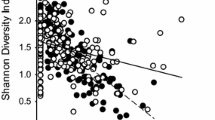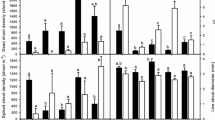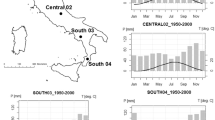Abstract
We address the neglected issue of ecological and evolutionary significance of root sprouting (RS) in plants. RS has been considered a sort of morphological curiosity. However, existing data of the Central European flora show that it occurs in about 10% of species. These species are therefore independent of a stem-derived bud bank in their resprouting. As sprouting from roots has been hypothesised to help plants survive disturbance, we used a large data set (2914 species with data on presence/absence of RS from Central Europe) to perform comparative analyses of its occurrence in disturbed habitats, evolution of RS in response to disturbance, and its distribution among individual plant lineages. To address these questions, we linked the data with species-level indicator values for disturbance, data on additional functional traits and phylogenetic data. We confirmed that RS ability is more frequent in plants growing in habitats subjected to disturbance, especially in annuals and clonal species. This contrasts with clonality via stem-based organs, which does not promote occurrence in disturbed habitats. Disturbance severity is the most important factor determining RS species distribution, whereas disturbance frequency plays a smaller role. RS is phylogenetically less conservative than sprouting from the stem-based belowground bud bank and thus can be easily acquired or lost in evolution, although these rates strongly differ between individual lineages. Evolution of RS seems to be driven largely by occurrence in disturbed habitats, and has appeared/disappeared independently of the presence of a stem-derived bud bank. Importantly, the data support the scenario in which colonisation of such habitats occurs prior to acquiring the RS ability, which develops only later. RS is hence a more important ecological trait than hitherto assumed. It constitutes an independent route of response to severe disturbance and its ecological effects and evolutionary patterns differ from stem-based clonality.




Similar content being viewed by others
References
Arber A (1950) The natural philosophy of plant form. Cambridge University Press, Cambridge
Bartušková A, Klimešová J (2010) Reiteration in the short lived root-sprouting herb Rorippa palustris: does the origin of buds matter? Botany 88:630–638
Bartušková A, Malíková L, Klimešová J (in press) Check-list of root-sprouters in the Czech flora: mapping the gaps in our knowledge. Folia Geobot
Beijerinck MW (1887) Beobachtungen und Betrachtungen über Wurzelknospen und Nebenwurzeln. Verh Kon Ned Akad Wetensch, Afd Natuurk, Tweede Sect Bd 25:1–146
Bellingham PJ, Sparrow AD (2000) Resprouting as a life history strategy in woody plant communities. Oikos 89:409–416
Byrd RH, Lu P, Nocedal J, Zhu C (1995) A limited memory algorithm for bound constrained optimization. SIAM J Sci Comput 16:1190–1208
Chytrý M, Rafajová M (2003) Czech national phytosociological database: basic statistics of the available vegetation-plot data. Preslia 75:1–15
Del Tredici P (2001) Sprouting in temperate trees: a morphological and ecological review. Bot Rev 67:121–140
Durka W, Michalski SG (2012) Daphne: a dated phylogeny of a large European flora for phylogenetically informed ecological analyses. Ecology 93:2297
Ferreira MC, Walter BMT, Vieira DLM (2015) Topsoil translocation for Brazilian savanna restoration: propagation of herbs, shrubs and trees. Restor Ecol 23:723–728
Fritz SA, Purvis A (2010) Selectivity in mammalian extinction risk and threat types: a new measure of phylogenetic signal strength in binary traits. Conserv Biol 24:1042–1051
Groff PA, Kaplan DR (1988) The relation of root systems to shoot systems in vascular plants. Bot Rev 54:387–422
Guerrero-Campo J, Palacio S, Perez-Rontome C, Montserrat-Marti G (2006) Effect of root system morphology on root-sprouting and shoot-rooting abilities in 123 plant species from eroded lands in north-east Spain. Ann Bot 98:439–447
Harmon LJ, Weir JT, Brock CD, Glor RE, Challenger W (2008) GEIGER: investigating evolutionary radiations. Bioinformatics 24:129–131
Harrison J, Moller M, Langdale J, Cronk Q, Hudson A (2005) The role of KNOX genes in the evolution of morphological novelty in Streptocarpus. Plant Cell 17:430–443
Herben T, Chytrý M, Klimešová J (2016) A quest for species-level indicator values for disturbance. J Veg Sci 27:628–636
Holden C, Mace R (1997) Phylogenetic analysis of the evolution of lactose digestion in adults. Hum Biol 69:605–628
Horvath DP (1998) The role of specific plant organs and polar auxin transport in correlative inhibition of leafy spurge (Euphorbia esula) root buds. Can J Bot 76:1227–1231
Huntley B (1993) Species-richness in north-temperate zone forests. J Biogeogr 20:163–180
Iwasa Y, Kubo T (1997) Optimal size of storage for recovery after unpredictable disturbances. Evol Ecol 11:41–65
Keeley JE, Pausas JG, Rundel PW, Bond WJ, Bradstock RA (2011) Fire as an evolutionary pressure shaping plant traits. Trends Plant Sci 16:406–411
Kerstetter RA, Hake S (1997) Shoot meristem formation in vegetative development. Plant Cell 9:1001–1010
Klimešová J (2007) Root-sprouting in myco-heterotrophic plants: prepackaged symbioses or overcoming meristem limitation? New Phytol 173:8–10
Klimešová J, de Bello F (2009) CLO-PLA: the database of clonal and bud bank traits of Central European flora. J Veg Sci 20:511–516
Klimešová J, Klimeš L (2006) CLO-PLA3: a database of clonal growth architecture of Central-European plants. http://clopla.butbn.cas.cz
Klimešová J, Martínková J (2004) Intermediate growth forms as a model for the study of plant clonality functioning: an example with root sprouters. Evol Ecol 18:669–681
Klimešová J, Sosnová M, Martínková J (2007) Life-history variation in the short-lived herb Rorippa palustris: effect of germination date and injury timing. Plant Ecol 189:237–246
Klimešová J, Kociánová A, Martínková J (2008) Weeds that can do both tricks: vegetative versus generative regeneration of the short-lived root-sprouting herbs Rorippa palustris and Barbarea vulgaris. Weed Res 48:131–135
Klimešová J, Malíková L, Rosenthal J, Šmilauer P (2014) Potential bud bank responses to apical meristem damage and environmental variables: matching or complementing axillary meristems? PLOS ONE 9(2):e88093
Korsmo E (1930) Unkräuter im Ackerbau der Neuzeit. Springer, Berlin
Latzel V, Dospělová L, Klimešová J (2009) Annuals sprouting adventitiously from the hypocotyl: their compensatory growth and implications for weed management. Biologia 64:923–929
Malíková L, Šmilauer P, Klimešová J (2010) Occurrence of adventitious sprouting in short-lived monocarpic herbs: a field study of 22 weedy species. Ann Bot 105:905–912
Martínková J, Klimešová J (2016) Enforced clonality confers a fitness advantage. Front Plant Sci 7:1–10
McIntyre GI (1972) Developmental studies on Euphorbia esula. The influence of the nitrogen supply on the correlative inhibition of root bud activity. Can J Bot 50:949–956
Midgley JJ (1996) Why the world’s vegetation is not totally dominated by resprouting plants; because resprouters are shorter than reseeders. Ecography 19:92–95
Miller AD, Roxburgh SH, Shea K (2011) How frequency and intensity shape diversity-disturbance relationships. Proc Nat Acad Sci USA 108:5643–5648
Orme D (2012) The Caper package: comparative analysis of phylogenetics and evolution in R. http://cran.r-project.org/web/packages/caper/
Pagel M (1994) Detecting correlated evolution on phylogenies: a general method for the comparative analysis of discrete characters. Proc R Soc Lond B 255:37–45
Palacio S, Maestro M, Montserrat-Marti G (2007) Relationship between shoot-rooting and root-sprouting abilities and the carbohydrate and nitrogen reserves of Mediterranean dwarf shrubs. Ann Bot 100:865–874
Pausas JG, Lavorel S (2003) A hierarchical deductive approach for functional types in disturbed ecosystems. J Veg Sci 14:409–416
Penzig O (1921–2) Pflanzen Teratologie, 2nd edn. Verlag von Gebrüder Borntraeger, Berlin
Peterson RL (1975) The initiation and development of root buds. In: Torrey JG, Clarkson DT (eds) The development and function of roots. Academic Press, London, pp 125–161
Pyšek P, Danihelka J, Sádlo J, Chrtek J Jr, Chytrý M, Jarošík V, Kaplan Z, Krahulec F, Moravcová L, Pergl J, Štajerová K, Tichý L (2012) Catalogue of alien plants of the Czech Republic (2nd edition): checklist update, taxonomic diversity and invasion patterns. Preslia 84:155–255
R Core Team (2015) R: a language and environment for statistical computing. Vienna Austria: R Foundation for Statistical Computing. http://www.R-project.org
Raju MVS, Coupland RT, Steeves TA (1966) On the occurrence of root buds on perennial plants in Saskatchewan. Can J Bot 44:33–36
Rauh W (1937) Die Bildung von Hypocotyl- und Wurzelsprossen und ihre Bedeutung für die Wuchsformen der Pflanzen. Nova Acta Leop 4(24):395–553
Revell LJ (2012) phytools: an R package for phylogenetic comparative biology (and other things). Methods Ecol Evol 3:217–223
Revell LJ (2014) Package ‘phytools’. https://cran.r-project.org/web/packages/phytools
Silva IA, Batalha MA (2011) Plant functional types in Brazilian savannas: the niche partitioning between herbaceous and woody species. Perspect Plant Ecol Evol Syst 13:201–206
Sosnová M, Herben T, Martínková J, Bartušková A, Klimešová J (2015) To resprout or not to resprout? Modeling population dynamics of a root-sprouting monocarpic plant under various disturbance regimes. Plant Ecol 215:1245–1254
Teichmann T, Muhr M (2015) Shaping plant architecture. Front Plant Sci 6:233
Vesk PA, Westoby M (2004) Funding the bud bank: a review of the costs of buds. Oikos 106:200–208
Wehsarg O (1954) Ackerkräuter. Akademie Verlag, Berlin
Wittrock VB (1884) Ueber Wurzelsprossen bei krautigarten Gewächsen, mit besonderer Rücksicht auf ihre verschiedene biologische Bedeutung. Bot Zbl 17(8, 9):227–232, 257–264
Wood SN (2011) Fast stable restricted maximum likelihood and marginal likelihood estimation of semiparametric generalized linear models. J R Stat Soc (B) 73:3–36
Acknowledgements
This study was supported by the Czech Science Foundation (PLADIAS Centre of Excellence, 14-36079G) and by research project 16-19245S. We are grateful to Jan W. Jongepier for language revision.
Author information
Authors and Affiliations
Corresponding author
Rights and permissions
About this article
Cite this article
Klimešová, J., Herben, T. & Martínková, J. Disturbance is an important factor in the evolution and distribution of root-sprouting species. Evol Ecol 31, 387–399 (2017). https://doi.org/10.1007/s10682-016-9881-0
Received:
Accepted:
Published:
Issue Date:
DOI: https://doi.org/10.1007/s10682-016-9881-0




